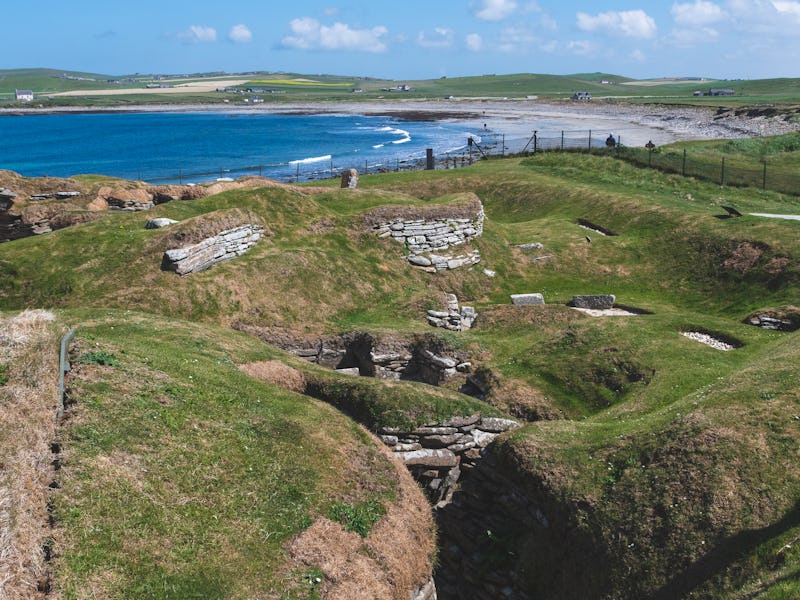Female migration to these remote Scottish islands ushered in a cosmopolitan era
Remains from the northern Scottish region of Orkney show female migrants were accepted into society and ushered in a wave of prosperity.

The remote Scottish islands of Orkney might not be the first place that comes to mind when you think of a cultural hub. But thousands of years ago, it was home to ancient peoples who built monuments, created art, and even hosted parties.
At the beginning of the Bronze Age, about 4,500 years ago, the islands saw a population shift. Primarily female migrants from other parts of Europe began to make their way to isolated Orkney.
Researchers writing in the journal Antiquity this week investigated the societal and familial roles that arose during an important time in the islands’ history. The early Bronze Age ushered in an era of peace, prosperity, and innovation for Orkney, and cultural changes related to migration likely played a large role in that shift.
Two Bronze Age houses from the Links of Noltland under excavation.
Here’s the background – While the islands are known for their robust stone structures built during the Neolithic, remains from Bronze Age Orkney are scarce. But a site on one of the northernmost islands was once the home of a farming community that existed in both the Neolithic and Bronze Age. Called the Links of Noltland, it houses a gravesite with over 100 burials.
Back in February, researchers published a report in the journal Proceedings of the National Academy of Sciences (PNAS) where they analyzed DNA found at Noltland. Researchers compared remains from the site to other Orkney burials across several time periods.
They discovered that a wave of people migrated to Orkney during the early Bronze Age — but sex seemed to be a determining factor in who was a newcomer.
Lineages from male individuals appeared to come from Neolithic-era peoples who had lived on the islands for some time. In contrast, female lineages could often be traced back to continental Europe.
The skeletal remains of a female, 19 to 20 years of age, whose ancestry could be traced back to continental Europe.
That means women were often the ones packing up and sailing to the islands, while men stayed in place. “I think this is due to the inheritance system here,” study co-author Graeme Wilson tells Inverse. “The men wanted to retain control of the farms so [they] sought female incomers.”
Wilson, a co-founder of Environment and Archaeology Services Edinburgh (EASE), has been involved with excavations at Noltland since 2006. He says the new Antiquity paper takes the DNA findings a step further to “integrate it with the other archaeological findings and tell a more balanced story.”
Family matters – For the new study, researchers used the DNA findings from the previous PNAS report to examine how society may have been organized at Noltland.
They mapped out the site’s tombs to see how certain factors in each person’s identity may have determined societal status. In all, there appear to be three main households buried in the graves there. Both cremated remains and whole bones are buried at the site, and remains vary in age from babies to adults.
Few grave goods were found at the site, which is typically an indicator of the wealth or status that someone held during life. But more importantly, there didn’t seem to be any distinction between where or how people were buried based on their age, sex, or lineage.
“The cemetery shows that the incomers were integrated and accepted, I think,” Wilson says. “I also think that they were influential and that many of the changes which occur around this time must be traced to their presence.”
A welcoming embrace – Because Orkney is so isolated, some researchers previously thought it may have been less welcoming to new cultures and ideas than other areas of the United Kingdom.
“Cut adrift to carve its own trajectory, it has been argued that there may even have been a conscious rejection by the islands’ population of new developments that were taking place elsewhere in Britain,” the study authors write.
But the remains at the Links of Noltland seem to show otherwise. As women came from faraway places in continental Europe, they brought new cultures with them to Orkney. And the burial practices on the island reveal a place where those newcomers were treated as equals.
The centuries following the great migration in Orkney were known as a peaceful and prosperous time for society there. “There was change, particularly with climate at Noltland,” Wilson says. “But the settlements adapted and the ways they did this successfully was due to new, better, ideas being brought in.”